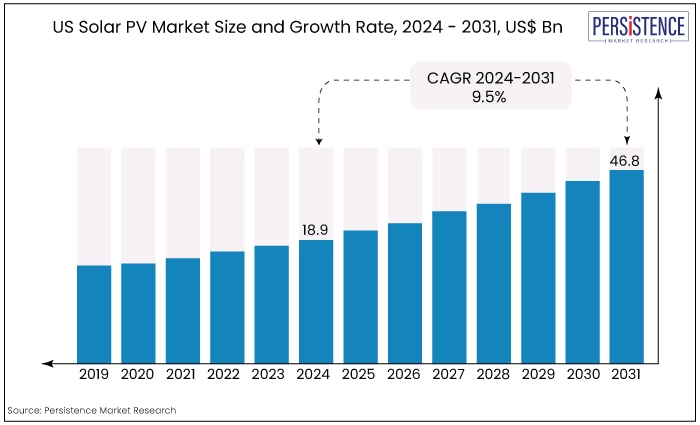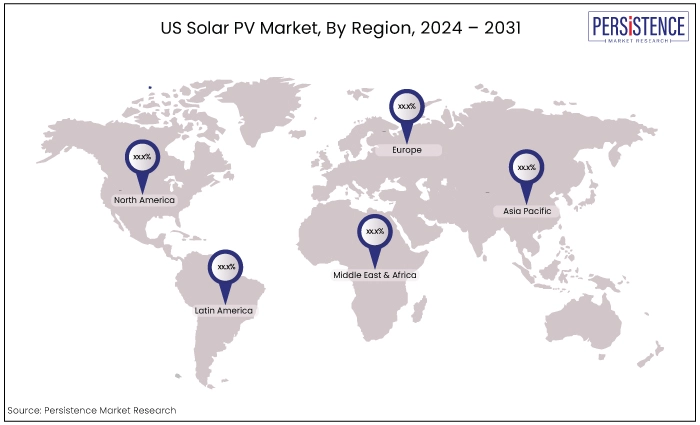ID: PMRREP34644| Upcoming | Format: PDF, Excel, PPT* | Energy & Utilities

The US solar PV market is estimated to reach a valuation of US$46.8 Bn by the year 2034, at a CAGR of 9.5%, during the forecast period 2024 to 2034.
Key Highlights of the Market
|
Attributes |
Key Insights |
|
US Solar PV Market Size (2024) |
US$18.9 Bn |
|
US Solar PV Market Size (2034) |
US$46.8 Bn |
|
Forecast Growth Rate (CAGR 2024 to 2034) |
9.5% |
|
Historical Growth Rate (CAGR 2019 to 2023) |
8.9% |
The US solar photovoltaic (PV) market is poised for significant growth from 2024 to 2034, driven by advancing technology, supportive policies, and increasing consumer demand for renewable energy solutions. The US solar PV market report provides a comprehensive analysis of key trends, market dynamics, and growth opportunities within the US solar PV sector over the next decade.
Innovations in solar PV technologies, including improvements in efficiency and reductions in manufacturing costs, are enhancing the competitiveness of solar energy compared to traditional fossil fuels.
Increasing awareness of climate change impacts and the benefits of renewable energy, coupled with declining solar PV system costs, are driving residential, commercial, and utility-scale solar installations across the US.
The US solar PV market is entering a transformative phase, driven by technological innovation, policy support, and increasing economic viability.
Stakeholders across the value chain, including manufacturers, developers, investors, and policymakers, are well-positioned to capitalize on the growing demand for clean and sustainable energy solutions.

The US solar photovoltaic (PV) market has experienced dynamic growth and transformation from 2019 to 2023 while exhibiting a CAGR of 8.9%. The historical growth was primarily driven by technological advancements, policy support, and shifting market dynamics towards renewable energy sources.
The period from 2019 to 2023 marked a transformative phase for the US solar PV market, characterized by significant growth in installed capacity, technological innovation, and supportive policy frameworks.
Businesses and industrial facilities also embraced solar PV technology during this period. Favorable economic incentives, such as tax credits and accelerated depreciation, encouraged C&I entities to invest in solar to achieve cost savings and meet sustainability goals.
Further, the residential solar PV segment showed remarkable expansion, buoyed by declining system costs, favourable financing options, and increasing awareness of energy efficiency.
Homeowners and residential developers increasingly adopted solar PV systems to reduce electricity bills and enhance property values. As the market continues to evolve, stakeholders are positioned to capitalize on opportunities presented by the ongoing transition towards clean and sustainable energy solutions.
Supportive Policies
Federal and state-level policies have played a pivotal role in fostering the growth of the US solar PV market. The Federal Investment Tax Credit (ITC), originally established in 2006 and subsequently extended, provides a substantial financial incentive for residential, commercial, and utility-scale solar installations.
State-level initiatives such as renewable portfolio standards (RPS) and net metering policies further incentivize solar PV adoption by mandating a minimum percentage of electricity generation from renewable sources and allowing solar PV owners to sell excess electricity back to the grid at retail rates.
Technological Advancements
Ongoing advancements in solar PV technology have enhanced the efficiency and performance of solar panels while reducing maintenance costs.
Innovations such as bifacial panels, thin-film technology, and improved energy storage solutions have expanded the applicability and effectiveness of solar PV systems across diverse geographical and operational contexts.
These technological advancements continue to drive down overall system costs and improve the reliability of solar PV installations.
Environmental Awareness
Increasing awareness of climate change and the environmental impacts of fossil fuel-based energy sources has driven demand for clean and sustainable alternatives like solar PV.
Businesses, municipalities, and individual consumers are increasingly prioritizing sustainability in their energy choices, driving demand for solar PV installations as a means to reduce carbon footprints and achieve environmental goals.
Grid Integration & Operational Challenges
Solar PV generation is intermittent and depends on weather conditions such as sunlight availability. As the penetration of solar PV increases, grid operators must manage the variability of solar generation to ensure grid stability and reliability.
This requires investments in grid modernization, energy storage solutions, and advanced forecasting technologies to balance supply and demand effectively.
The capacity of existing grid infrastructure to accommodate distributed generation from solar PV systems can be limited in certain regions.
Upgrading transmission and distribution networks to handle bi-directional flows of electricity from solar PV installations may require significant investments and regulatory approvals, which can slow down deployment.
Utilities sometimes face challenges in integrating large-scale solar PV projects into their operational planning. Issues such as voltage regulation, power quality, and grid congestion may arise, requiring utilities to implement grid upgrades and invest in new technologies to maintain system reliability, which may impede the growth of the US solar PV market share.
Inconsistent Policies
The solar industry relies on government policies and incentives to make solar energy more affordable and attractive. Inconsistency in these policies can create uncertainty for potential adopters.
This tax credit helps offset solar installation costs, but it's scheduled to gradually decrease in the coming years. This uncertainty discourages some from going solar.
These policies allow homeowners to sell excess solar energy back to the grid. However, these policies vary by state and utility company, making it difficult for some to benefit.
New Technological Advancements
Advancements in solar PV technology continue to drive down costs and enhance efficiency, opening new opportunities for the US solar PV market participants. Continued research and development in solar PV materials, such as perovskite and thin-film technologies, promise higher efficiency and lower manufacturing costs.
Industry players investing in these technologies stand to gain a competitive edge by offering more cost-effective and efficient solutions to consumers. The integration of energy storage systems with solar PV installations is becoming increasingly crucial.
Innovations in battery technology and grid-scale storage solutions enhance the reliability and flexibility of solar PV systems. Companies involved in energy storage technologies can capitalize on the growing demand for integrated solar-plus-storage solutions for both residential and commercial applications.
Smart inverters, and advanced power electronics mark crucial market trends as play a vital role in optimizing solar PV system performance and supporting grid stability. Companies developing and deploying smart grid technologies and grid integration solutions are well-positioned to meet the evolving needs of utilities and grid operators as solar PV penetration increases.
Solar PV Represents 85% of Total Sales
|
Market Segment by Type |
Market Value Share 2024 |
|
Solar Photovoltaic |
85% |
Based on type, the US solar PV market is further categorized into solar photovoltaic, and concentrated solar power, where the solar photovoltaic segment dominates the market with 85% of the total market share.
The solar photovoltaic segment maintains a commanding presence within the US solar PV market, driven by technological advancements, supportive policies, economic competitiveness, and increasing consumer demand.
As the market continues to evolve, solar PV market share is expected to play a pivotal role in shaping the future of sustainable energy generation in the United States, further solidifying its dominance in the renewable energy landscape.
Utility Sector Contributes 65% in Total Adoption
|
Market Segment by Application |
Market Value Share 2024 |
|
Utility |
65% |
Based on application, the US solar PV market is further classified into residential, commercial and utility, where the utility segment dominates the market with 65% of the total market share.
The US solar PV market growth is predicted to be boosted by the shift in consumer preference towards renewable energy generation, driven by concerns for environmental protection.
The rise in consumer consciousness regarding environmental conservation is anticipated to lead to the advancement of sustainable energy sources and a decrease in carbon emissions, hence fostering US Solar PV market expansion.
In the forecast period, the residential category is further expected to experience the highest compound annual growth rate (CAGR) of 13.9%.
The demand for solar photovoltaic (PV) systems in the United States is projected to increase between 2024 and 2034 due to the growing use of renewable energy sources at the home level.

January 2023 -
Tesla, a leading global firm, announced the launch of Megapack, a utility-scale energy storage solution developed to complement solar PV installations and enhance grid stability and renewable energy integration.
October 2023 -
Vivint Solar launched new financing options and expanded its service offerings to include integrated solar and energy storage solutions for residential customers.
March 2024 -
Sunrun announced plans to collaborate with utilities to deploy virtual power plants (VPPs), aggregating solar PV systems and energy storage to support grid reliability and provide grid services.
The US Solar PV market is becoming highly competitive, with several leading solar companies providing better commercial opportunities to their end consumers while utilizing new and high-end technologies in the manufacturing of shoes in different categories.
Major players in the solar energy market are utilizing high-end machinery to pacify their production with smart and automated machining tools, which eventually cater to evolving consumer needs.
The US solar PV market is estimated to exhibit a CAGR of 49.5% during the forecast period.
The US solar PV market is segmented based on type, and application.
First Solar, SunPower, Suniva, 1Soltech, and Sharp are some of the major companies in the market.
Solar photovoltaic is the dominant product type segment.
The utility sector represents the largest application segment.
|
Attributes |
Details |
|
Forecast Period |
2024 - 2034 |
|
Historical Data Available for |
2019 - 2023 |
|
Market Analysis |
US$ Billion for Value |
|
Key Regions Covered |
|
|
Key Companies Profiled |
|
|
Pricing |
Available upon request |
By Type
By Application
By Region
Delivery Timelines
For more information on this report and its delivery timelines please get in touch with our sales team.
About Author